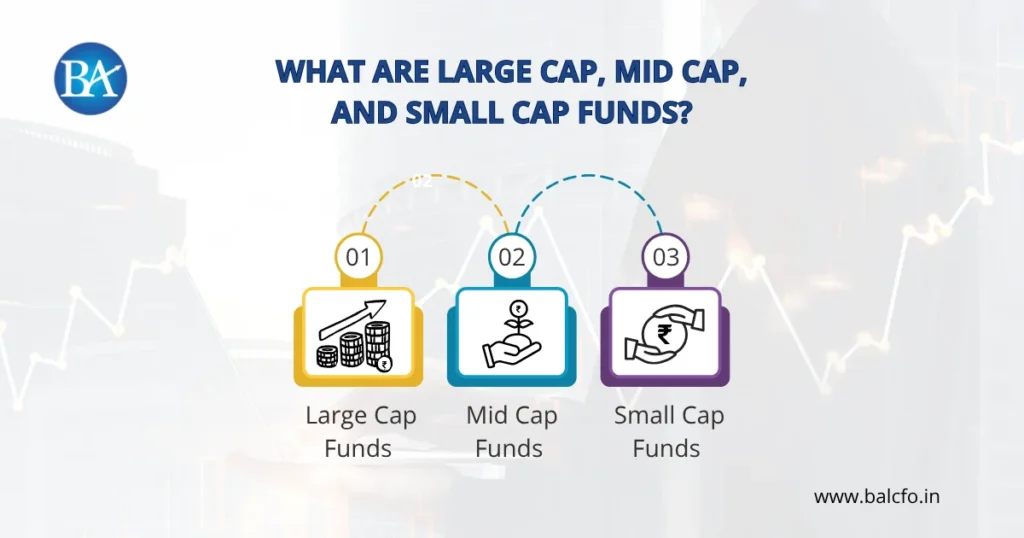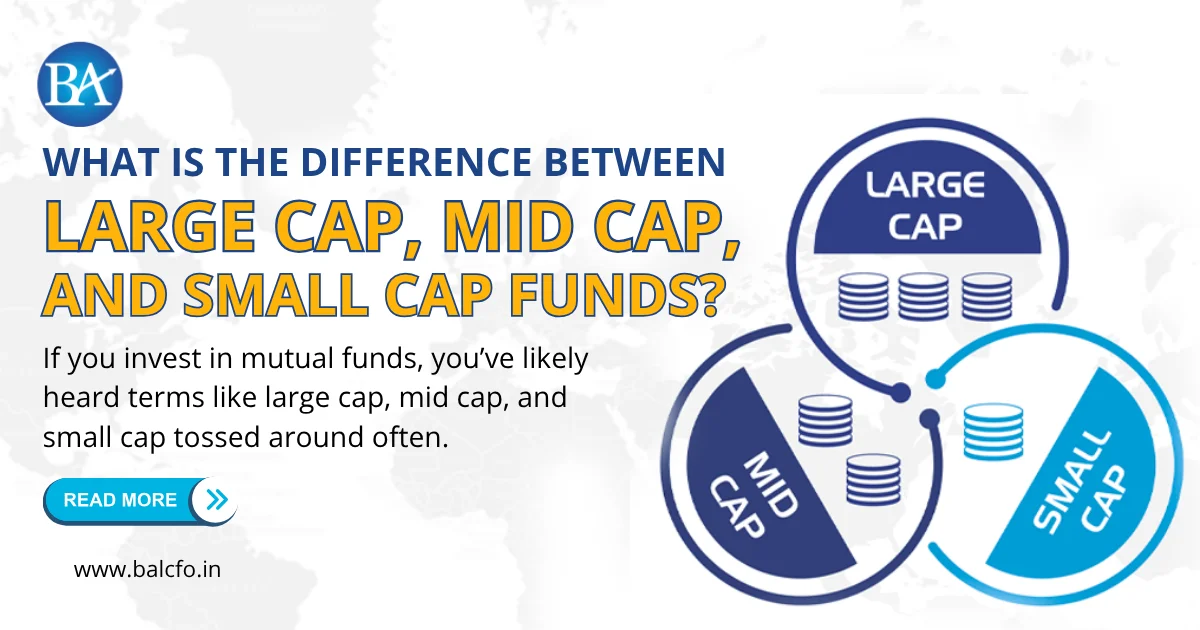If you invest in mutual funds, you’ve likely heard terms like large cap, mid cap, and small cap tossed around often.
But here’s the thing: most investors invest blindly into funds without truly understanding what these categories mean.
Each one behaves differently, carries its own level of risk, and fits a specific stage of your financial journey. Knowing the difference between large cap, mid cap, and small cap funds helps you invest intentionally rather than emotionally.
Let’s break them down one by one — in plain language, without the jargon.
Table of Contents
ToggleWhat are Large Cap, Mid Cap, And Small Cap Funds?

Mutual funds are classified by the size of the companies they invest in. Market capitalisation, the total value of a company’s shares, determines where a company stands.
- Large Cap Funds invest in the top 100 companies in India by market capitalisation.
- Mid Cap Funds invest in companies ranked between 101 and 250.
- Small Cap Funds invest in companies ranked 251 and beyond.
These classifications are defined by SEBI to maintain transparency across the mutual fund industry.
So when you invest in any of these categories, you are basically deciding how much risk and volatility you’re comfortable with.
Large Cap Funds: The Foundation of Stability
Large Cap Funds are the steady players in your portfolio.
They invest in blue-chip companies with proven track records, strong governance, and reliable cash flows — names like Reliance Industries, Infosys, HDFC Bank, and TCS.
Key Traits:
- High liquidity and lower volatility
- Ideal for beginners or conservative investors
- Provide moderate but stable returns over time
Why They Matter:
Large funds often outperform when markets are turbulent. During uncertain economic periods, money tends to flow into these stable companies.
Their consistency makes them the anchor in a diversified portfolio.
Investors often start their SIP journey in Large Cap, Mid Cap, and Small Cap Funds through trusted Mutual fund distributors in Delhi NCR, ensuring the right mix of growth and safety.
Mid Cap Funds: The Growth Drivers
Mid Cap Funds sit right in the middle — not as safe as large caps, not as volatile as small caps.
They focus on emerging businesses that have moved beyond the startup phase but still have significant growth potential.
Key Traits:
- Balance between risk and return
- Higher potential upside during bull markets
- More volatile than large caps but less risky than small caps
Why They Matter:
Mid Caps represent the “sweet spot” for investors with moderate risk appetite.
They tend to outperform when the economy expands, as companies in this segment grow faster than industry giants.
A well-chosen mix of Large Cap, Mid Cap, and Small Cap Funds can create a portfolio that captures both stability and momentum a strategy often recommended by SIP distributors in Gurgaon for long-term investors.
Small Cap Funds: The High-Risk, High-Reward Zone
Small Cap Funds invest in emerging or niche companies that are often undiscovered by large institutional investors.
They’re agile, fast-growing, and capable of delivering exceptional returns — but they also swing harder during market corrections.
Key Traits:
- Highest volatility and risk
- Massive growth potential over the long term
- Longer investment horizon needed (7–10 years minimum)
Why They Matter:
Small Caps bring the “alpha”, the extra edge of performance, that many portfolios lack.
However, they’re best suited for investors who can tolerate temporary losses and stay invested through market cycles.
Comparing Risk, Returns, and Volatility
| Category | Risk Level | Return Potential | Ideal Investor | Holding Period |
|---|---|---|---|---|
| Large Cap Funds | Low | 10–12% | Conservative, stability-focused | 3+ years |
| Mid Cap Funds | Moderate | 12–15% | Moderate risk takers | 5+ years |
| Small Cap Funds | High | 15–20%+ | Aggressive investors | 7+ years |
A mix of Large Cap, Mid Cap, and Small Cap Funds helps balance your exposure. You get the reliability of large caps, the growth potential of mid caps, and the performance spikes of small caps — all in one structure.
How to Build the Right Allocation
The right balance depends on your risk tolerance and time horizon.
- Conservative Investor: 70% Large Cap, 25% Mid Cap, 5% Small Cap
- Balanced Investor: 50% Large Cap, 30% Mid Cap, 20% Small Cap
- Aggressive Investor: 30% Large Cap, 35% Mid Cap, 35% Small Cap
If you invest through SIP distributors in Gurgaon, they can help you set up automated monthly allocations aligned with your goals.
For example, someone saving for a house in 8 years might allocate higher to mid and small caps for growth, then gradually shift back toward large caps closer to the goal.
When Each Fund Type Performs Best
- Large Cap Funds: During uncertain or bearish markets, when investors seek safety.
- Mid Cap Funds: When the economy begins to recover, and growth stories emerge.
- Small Cap Funds: During strong bull markets, when liquidity and sentiment are high.
Understanding this pattern allows you to rebalance proactively rather than reacting emotionally to market noise.
Taxation Rules for Large Cap, Mid Cap, And Small Cap Funds
All three are classified as equity mutual funds and taxed similarly:
- Short-Term Capital Gains (STCG): 15% if held for less than one year.
- Long-Term Capital Gains (LTCG): 10% if gains exceed ₹1 lakh per financial year.
Dividends, if any, are taxed as part of your income based on your tax slab.
4 Common Mistakes Investors Make While Investing in Mutual Funds

- Overexposure to Small Caps: Chasing past performance without understanding volatility.
- Ignoring Rebalancing: Holding on too long when market cycles shift.
- Lack of Diversification: Investing in only one category instead of balancing across all.
- Neglecting SIP Discipline: Stopping SIPs during market dips instead of continuing.
Professional Mutual fund distributors in Delhi NCR often remind clients that consistency matters more than timing the market.
Conclusion: The Right Mix Wins Every Time
No single fund category outperforms forever.
The smart move is understanding what role each plays and then combining them thoughtfully.
A portfolio blending Large Cap, Mid Cap, and Small Cap Funds creates balance — steady growth, controlled risk, and exposure to future winners.
The real art of investing lies in staying consistent, not chasing fads.
BellWether – Your Personal CFO

If you want help building a personalised allocation across Large Cap, Mid Cap, and Small Cap Funds, speak with a BellWether Associates.
Our Mutual fund distributors in Delhi NCR can guide you through goal-based SIP strategies, while SIP distributors in Gurgaon can help set up automated investments tailored to your risk profile and timeline.
FAQs About Large Cap, Mid Cap, And Small Cap Funds
1. Which Is Best for Beginners?
Large Cap Funds are ideal starting points due to stability and lower volatility.
2. Can I Invest in All Three Together?
Yes. Most experts recommend a combination of Large Cap, Mid Cap, and Small Cap Funds for balanced risk and return.
3. How Long Should I Stay Invested?
At least 5 years for mid caps, 7 years for small caps, and 3 years for large caps.
4. Are SIPs Better Than Lumpsum Investments?
Yes. SIPs average out market volatility. Many SIP distributors in Gurgaon help automate this process for long-term wealth building.
5. Do These Funds Change Their Stocks Often?
Mid and small caps see more frequent churn due to changing business cycles, while large caps stay more stable.






